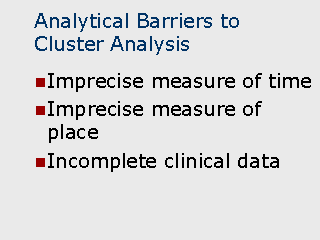Imprecise measure of
time
Since disease cluster studies tend to be retrospective by nature, much of the data
collected tends to not have been formally documented but rather, resides in the memories
of individuals. Unless the dates of doctor visits, hospital admittances, etc. can be
researched, the dates of the disease incidences are often approximated. Imprecise
measure of place
Two issues arise when defining locations:
1. The first issue deals with the concept of location is operationalized based on
exposure. In the case of an occupational exposure to a health risk, the appropriate
definition place would be the location of a worksite. If the exposure is not not
occupational, the appropriate definition of place would, in the absence of the person
travelling, be a person’s residence.
2. The second issue deals with the precision of the place definition. The most precise
measure of place is by latitude and longitude. Given a coordinate pair, location can be
defined to an accuracy of within several feet. Even if latitude and longitude are not
available, GIS programs have the ability of estimating them based on a street address and
appending them to a case record. In many cases, however, the exact address is not
available. Instead a regional definition of place may be used such as 5 digit zip code,
census tract, or block group. In this case, the actual location is often assumed to be the
geometric center (centroid) of the region. When this occurs, much of the distinction
regarding the proximity of cases to one another is lost since all of the cases in the same
region are most likely assigned the same coordinates.
Incomplete clinical data
May be the result of self-reporting or the limited reporting of clinical records with
geographic identifiers.
